Dental Services You Need During Braces
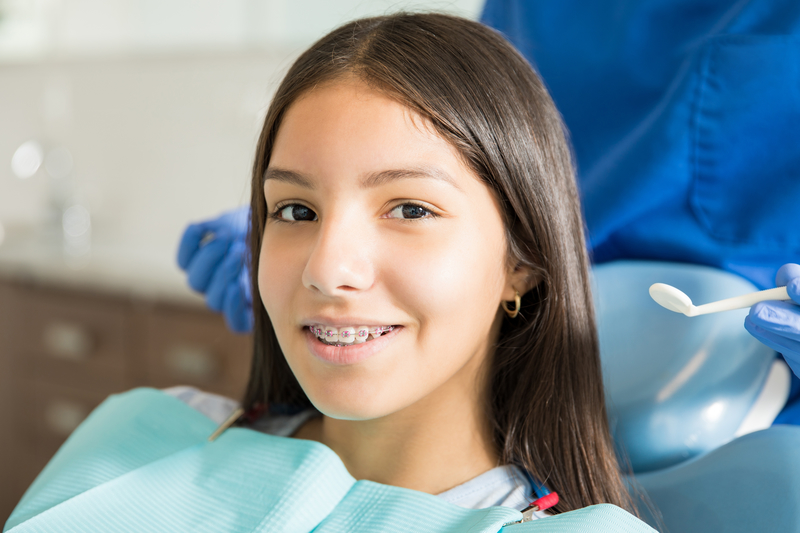
Getting braces through an orthodontist does not mean you should stop seeing a dentist for dental services. In fact, you may even need to get dental services more often with braces. This is because brackets and wires inevitably raise your risk for getting food and plaque stuck in your teeth. Those substances can then lead to quicker tooth decay, gum problems and tooth erosion. Find out what you can expect from your orthodontic visits and why you should keep scheduling in dental services during your treatment.
How Do Braces Change Your Teeth?
Not everyone will get braces during their lifetime. However, for those that do, they can change a smile in incredible ways. You may see children wearing braces from time to time. This is just so they can get a great smile, but that is part of it. Children should see the orthodontist around age 7 or 8 to determine if bite or alignment issues are present. If so, a child could grow up with speech impediments, problems with tooth decay and gum disease, and difficulty chewing, eating and biting. With interceptive orthodontics—or child orthodontics—we can correct those problems so a child develops properly.
With adults and teens, straightening treatment generally starts around age 11 or 12 and older. This is when most (if not all) of the adult teeth have come into the mouth. However, it’s common for the adult teeth to come in crooked, which can make people self-conscious about their smiles. When patients decide to get braces to straighten their teeth, studies show that confidence grows and people show their smiles more. That confidence can lead to more success in the future, motivation to do more and be more, and better oral health.
Straightening the teeth makes the teeth easier to clean. This is because crooked teeth can create areas in the mouth where the teeth are incredibly hard to clean. If you can’t brush nooks and crannies well or if you can’t pass floss through the teeth, those areas are likely to decay. Teeth that are crooked or at different angles also have different amounts of pressure placed on them, which can cause the teeth to crack or break under pressure. That is why straightening the teeth can help prevent not only dental emergencies, but also problems like tooth decay and gum disease.

Changes You Want to Avoid
With your dental health, you always want to invest in dental services like dental cleanings, comprehensive exams and your own at-home cleaning. If not, you can start to develop problems with cavities and gum disease. Both of these conditions (as well as bad breath, oral sores and more) stem from poor oral hygiene. When you eat, bacteria in the mouth mix with sugars in your food to create a sticky film called plaque. That film is acidic and it sticks to your teeth instead of being swallowed. The acid erodes the layers of your teeth, decaying them to create cavities. This is how they form, and they can happen much easier with braces.
Three types of braces you can choose (traditional, lingual, ceramic) will require brackets and wires attached to your teeth. The brackets are bonded to the center of your teeth, with a wire that runs through them. Your brackets are areas where plaque and food can easily get stuck. If they become stuck or particles build up around your brackets, this can create areas of decay rather quickly. Many people also don’t floss like they should with braces because it takes just a bit longer. However, when food sticks around and you skip flossing, you are leaving about 40% of your tooth surfaces open to decay. That means, when you get your braces off, you’ll be left with areas of tooth erosion (or craters) and cavities.
You also want to avoid foods with dyes in them, including drinks. When you drink or eat something with dyes (like blueberries, strawberries, blackberries and drinks died those colors), then your tooth color can change over time. This could mean that you have small squares on all of your teeth at the end of treatment that are a different color than the rest of your teeth. Soda, juices and carbonated drinks can all do this as well, except that they will also wear away parts of your teeth.
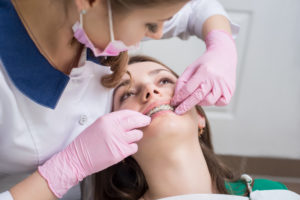
Continue Dental Services During Braces
All of those changes to your teeth can be avoided if you keep up on your personal hygiene at home and dental services in-office. This means, you should:
- Brush your teeth every single day, after every single meal, for two minutes each time you brush. Practice brushing at 45-degree angles to dislodge food from brackets and cover all the tooth surfaces. Use a proxabrush to dislodge stuck food even easier.
- Floss each day, at least 1-2 times. Use a floss threader or threadable floss to make this easy for you.
- Use a waterpik tool if you tend to get food stuck in specific places.
- Keep up on your braces adjustments and your orthodontic appointments.
- For dental services, make sure you visit the dentist at least twice a year for comprehensive exams and dental cleanings.
We want to focus on that last one. Dental cleanings and comprehensive exams are so important for the health of your mouth. With dental cleanings, the hygienists can do thorough cleanings on your teeth and brackets and spot the signs of erosion, decay and color changes. Those professionals can spot the signs of decay and gum issues. If needed, we can work with them to remove certain brackets where dental work is needed. Orthodontists and dentists are not the same even though they have had the same schooling. Make sure you are visiting both during your time with braces. If you want to avoid problems with cleaning brackets and wires, ask us about our Invisalign treatment option. You can do this by calling Belmar Orthodontics at (303) 225-9016!
Get Your Braces in Time for Back-to-School

Going back to school can be an exciting time whether you’re a child, teen or an adult. However, if you have recently had your braces put on or plan to get them before school starts, there are some things you should prepare for. Those include planning ahead so that you can clean your teeth at school, that you have food you can eat with braces and more. As you go back to school this year, use these tips for taking care of your braces and for showing them off to your peers!
Should You Get Braces?
Many people see braces and try to decide if they are right for them. Receiving orthodontic care does take time, but it’s time well spent. Most patients are generally wearing their orthodontic appliance for 18-24 months at a time. However, you can achieve a straight smile that will last you the rest of your life.
There are incredible benefits that come with getting braces, and we’re not just talking about getting straighter teeth. Braces can correct a patient’s problems with bite and alignment. These types of problems can create speech impediments over time and can make it difficult for patients to bite, chew, smile and more. Add crooked teeth on top of that, and the teeth also become much more difficult to clean. When they are more difficult to clean, patients generally miss cleaning areas that eventually decay. Without orthodontic treatment, you raise your risk for tooth decay and gum disease, as well as dental emergencies. Crooked teeth and bite problems can lead to broken and cracked teeth over time.
However, braces can get rid of all those risk factors that lead to chronic dental problems. And you don’t really have to do much except keep your braces clean! Studies also show that people who straighten their teeth tend to smile more, and they actually have a major confidence boost that stays with them. Going back-to-school is a great time to get that extra confident boost!

Choosing Which Braces You Want
In the past, patients only had one dental option. Today, you have at least four options. At your consultation, you can learn about and choose from these options:
- Traditional Metal Braces: The metal brackets and wires many people think of when they think “braces”. The metal brackets attach to the front of every tooth and are held in place by a metal wire that goes along the bottom and top teeth. The molars have metal bands that go all the way around the tooth in the back to keep the braces very sturdy.
- Ceramic Braces: These are designed just like traditional metal braces, but they are made from white, ceramic material to blend with the teeth. Even the wire can be made white for patients.
- Lingual Braces: With Incognito Lingual Braces, you can achieve the same results as traditional braces with a hidden treatment apparatus on the tongue-side of your teeth. These braces consist of metal that is custom-molded to fit on the back of all your teeth. The metal covers the entire back instead of simply consisting of a bracket. However, there is still a small bracket that holds the metal wire in place. The main advantage of lingual braces is that they can straighten and correct bite problems without being seen.
- Invisalign: This treatment consists of transparent aligners custom-made for a patient’s teeth that they switch out every week. Over time, crooked teeth become straight. The aligners can be removed for any activity (eating, brushing, sports), however, they can’t correct major bite issues.

Watch What You Eat
With any new thing, there is always a learning curve. Braces are no different. For the first few days, your mouth will have to adjust to having an orthodontic appliance attached to the teeth. The newness of your braces will fade, but the need to take care of them won’t fade. One of the main things you need to watch out for with braces is what you eat. Many students get lunch from the cafeteria, snack bars, or fast food places. If this is you, be careful what you eat and aim to avoid foods such as:
- Hard candies: These generally contain lots of sugar and chewing on them can break brackets and wires.
- Avoid hard foods such as nuts, chips, popcorn (because of kernels), apples, crusty bread, carrots or hard vegetables.
- Ice: Never chew ice, as this can break orthodontic appliances and can crack or break a tooth. Always suck on ice; never chew.
- Sticky Sugary Foods. These include caramels, taffy, licorice, Tootsie Rolls, Starburst, Sugar Daddies, Skittles and candies that are similar.
- Gum: This gets stuck in all your orthodontic appliances and most are sugary, meaning that stuck food will be able to sit on your teeth and eat away at your tooth enamel.
Nobody wants to get back-to-school and have a dental emergency happen. If you always watch what you eat, you don’t have to worry about dental emergencies and serious oral health issues.
Get Your Braces in Time for Back-to-School
Do you want to make an amazing transformation this year? Start with your smile! Your smile is one of the first things others notice. You want to make that smile shine. For the perfect smile you are envisioning, we can help make it a reality! Simply call Belmar Orthodontics today at (303) 225-9016 for your free consultation!
Cavity Treatment During Braces
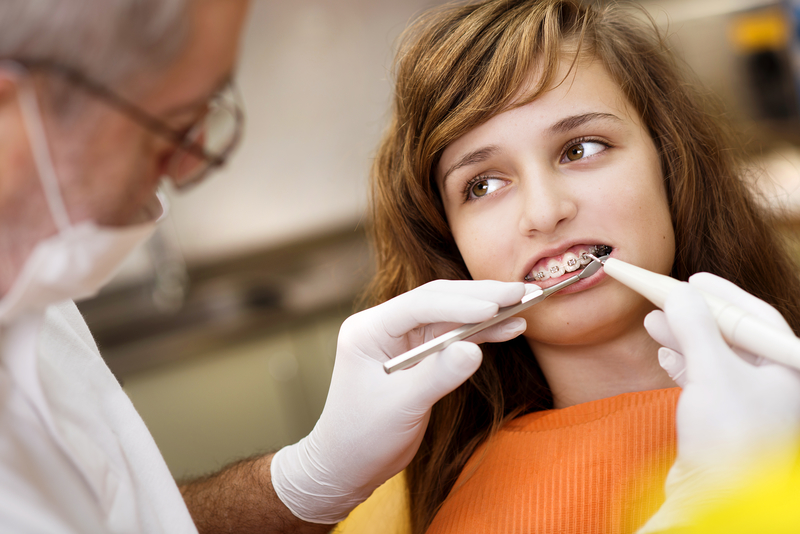
Did you know that an orthodontist and a dentist are not the same? Only a dentist can help with cavities, gum disease and more, while only an orthodontist can straighten your teeth in a certain way. A patient’s time with braces is a time when cavities happen very quickly, because the teeth are harder to clean. To prevent cavities during your time with braces, it is vital that you continue to see a dentist. If you do happen to get a cavity, find out what that cavity treatment will look like!
Proper Oral Hygiene
The American Dental Association recommends that every patient brush their teeth at least twice a day to avoid tooth decay. Brushing after every meal is even better for avoiding plaque buildup that leads to decay. Every patient should also floss their teeth at least once a day. Using fluoride toothpaste is best, because fluoride helps coat the teeth in a protective layer that prevents decay and keeps tooth enamel stronger. Patients can also benefit from mouthwash, as it can kill bacteria that would otherwise create plaque.
However, these recommendations are for people that don’t have braces. Every single person—children, teens and adults—should follow these recommendations. Infants should not use fluoride or mouthwash, but their child toothpastes generally have safe amounts of fluoride in them. If you are a patient that is receiving orthodontic care via braces, you have to go the extra mile with your oral hygiene. That means more frequent brushing, more flossing and watching what you eat.
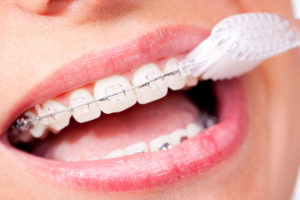
Taking Care of Braces
Braces can be tricky to clean. However, their design provides the best and quickest way for you to straighten your teeth, which is why traditional metal braces have been around for so many decades. Metal braces, ceramic braces and lingual braces all have a brackets-and-wires design.
However, with braces, you must be meticulous with cleaning them or you will have food and plaque get stuck places. If you don’t unstick those substances, they will quickly erode your tooth enamel and cause decay around your appliances. This can happen on every tooth as well.
Follow these tips for cleaning your braces:
- Brush after every single meal. This reduces staining and bacteria buildup. Use a regular soft-bristled brush and brush down from the top, then up from the bottom. Brush in all different directions to dislodge food.
- Use a threadable floss or a floss threader. Both will require that you thread the floss through each space between your teeth. You will have to go under the wire to do this, and it will take slightly longer than normal flossing. This is one of the most important oral hygiene recommendations to follow!
- Use helpful tools. A proxabrush is a small braces brush that can help unstick foods. It looks like a tiny Christmas Tree brush. A waterpik is also helpful. This is a tool that helps blast away food particles with a stream of water.
Tooth Decay with Braces
Many children and teens skip flossing or brushing here and there. Every time you skip on an oral hygiene habit, it increases your risk for tooth decay—or cavities—with braces. Your time with braces is one where you have to be super careful about your oral health. Most people picture their beautiful smile after getting their braces off, but they don’t think about cavities and tooth erosion. You can end up with tooth decay and parts of your teeth that have eroded due to your oral hygiene habits with braces.
Nobody wants to spend 18-24 months perfecting their teeth only to be disappointed in their smile. That’s why oral hygiene is so important. Tooth decay happens rapidly, and it can happen where the brackets are bonded to your teeth and in-between your teeth because it is harder to floss. Normally, you would simply visit the dentist and have your cavity removed and filled. However, cavity treatment is a bit different with braces.
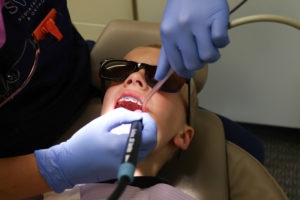
Cavity Treatment with Braces
Cavity treatment is slightly harder if you have braces, but not impossible. Generally, decay happens between teeth cracks and around brackets and wires. If you have tooth decay that is in a tricky spot, we can remove your wire so that a dentist can provide you with a proper cavity treatment. You will have to have your appointments scheduled close together (dentist and orthodontist) so that you can get your cavity filled and your wire replaced.
In severe cases of tooth decay, we may have to remove a bracket from the tooth if it interferes with the dental work that needs to be done. We only do this in certain cases, and we replace the missing part as soon as possible so your teeth don’t move. Cavity treatment—with taking out the tooth decay and filling it—is the same with braces as it is without, only you have to work around orthodontic appliances if you have braces. Always let us know if you have tooth sensitivity, sharp (and even mild) pain when chewing and if you have sensitivity to hot or cold foods. This signals that there may be a more severe cavity.
Prevent Cavity Treatment
The goal of every patient—old and young—is to avoid tooth decay altogether. If you do, you’ll never have to worry about cavity treatment with braces. If your decay is small and in a tricky spot, you may have to wait until your braces are off to receive your cavity treatment. That might make your cavity grow larger, which is something you don’t want. Always see the dentist to check your mouth for tooth decay before you receive orthodontic treatment. This can avoid many problems in the future.
If you are prone to getting cavities or you have weak enamel, consider receiving Invisalign treatment instead of getting brackets and wires. This will help you avoid problems with cavities and needing to get cavity treatment. If you have tooth pain or want to learn more about cavity treatment with braces, call Belmar Orthodontics today at (303) 225-9016!
Teaching Children Good Oral Hygiene Habits

If you teach a child good oral hygiene habits early on, odds are that they will have better oral hygiene habits when they are teens and adults. As soon as a toddler gets their first tooth, it’s essential to start brushing and flossing their teeth. Afterwards, you will need to teach them the basics of good oral hygiene practices, especially when it comes to wearing braces. Find out what those basics are and what you should be thinking about for your child’s oral health!
Teaching Good Oral Hygiene Early
Good oral hygiene habits are essential for a healthy mouth and especially during orthodontic care. Many children need early orthodontics, which is also known as “child orthodontics”. This is when bite and alignment issues are corrected around age 7 or 8 to avoid serious problems later on. However, we hope that every child has good oral hygiene habits established well before this visit. Otherwise, not only will a child be dealing with bite and alignment issues, but they will also be dealing with tooth decay.
As soon as your child gets their first tooth as a baby, you need to start brushing that tooth. Brush it morning and night with a rice-size amount of fluoride toothpaste. Also make sure to clean your baby’s gums with a wet cloth after feedings. Once they start to grow, begin teaching them how to brush their teeth properly. You will have to help brush your child’s teeth for the first couple of years until they have the dexterity in their hands to do it themselves. Flossing will come later as more teeth come in.

Learning to Brush
Brushing the teeth is one of the most important habits a child can have. Brushing long enough is key for a healthy mouth. Make sure you get a toothbrush that fits the size of your child’s mouth. There are brushes for infants, toddlers, children, teens and adults. All will be different sizes and some children brushes will come in fun shapes and colors to help children brush.
Children can’t always tell how long they have been brushing. Having them brush their teeth for a duration of a song or brushing your teeth alongside them to make sure they brush long enough. When they are old enough to have braces, brushing is even more important than before to avoid tooth decay. Food that gets stuck in brackets can cause rapid decay. Make sure they brush longer and at different angles to dislodge food. When children are first learning, brush with them as many days as it takes when first learning to brush their teeth. Do the same when they learn to brush with braces.
Flossing 101
Children won’t have to floss until they are toddlers. The baby teeth are spaced out until they all come in. Kids will have a total of 20 baby teeth that will start to come closer together as a baby ages. Until a child has the dexterity to use floss like an adult, it’s smart to invest in flossers. These are secure, hand-held flossing tools that children can put in between their teeth to easily dislodge food. Ask us about mouthwash and fluoride products to see if they should be part of your child’s oral hygiene routine as well.
See a Dentist and Orthodontist
Starting from an early age, children need to start visiting the dentist. By age 7, they should see us for an orthodontic exam as well. Dental visits themselves are so important that most dental insurances cover those twice-a-year visits. These biannual visits generally consist of comprehensive exams and dental cleanings. At first, children may be nervous about visiting a dentist. Offices can be large with busy equipment that children aren’t familiar with. Dental tools can also be loud, which can make children nervous. However, these visits are nothing to worry about whether it is a dentist or orthodontist.
To help your child get used to being in an office, make sure you go to a pediatric dentist instead of a general dentist while they are young. Pediatric offices (such as our orthodontic one) has staff that is trained to work well with children. Dr. Hardyl has experience with children on a daily basis. He was trained in both dentistry and orthodontics and can spot the signs of dental issues early-on. His staff knows what kids worry about and they know how to explain dental and orthodontic terms so a child can understand. An exam sounds serious, but it’s really just Dr. Hardy looking inside your child’s mouth for any bite, alignment or dental problems. If a child hasn’t seen Dr. Hardy by age 7, make sure to get them in for an examination!
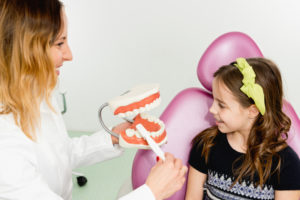
Good Habits for Life
Start children out young when teaching them good oral hygiene. If you make a habit of brushing and flossing, children will see that example and will follow it. When you help them learn good oral hygiene habits as soon as they can talk and understand, they can start keeping their mouth clean themselves. There are many resources online to help teach children specifics of brushing, flossing, and for learning about dental hygiene. We help children every day with brushing, flossing, caring for braces and establishing good oral hygiene. Call Belmar Orthodontics at (303) 225-9016 with any and all questions you have about your child’s oral health. Let us help you as you and your child learn to establish good oral hygiene habits together!
Foods and Drinks that Hurt Your Teeth

Braces is an amazing time to get a straighter, more beautiful smile. However, wearing braces on your teeth make them much harder to clean than they were before. This is especially true when it comes to certain foods and drinks. We have a list of foods that you should avoid during your orthodontic treatment because those foods stick to the teeth. You never want food to stay stuck in your braces, as this leads to tooth decay and demineralization. We can help you to know what foods and drinks to stay away from during your orthodontic treatment. We can also help you to know how to properly clean your teeth so you don’t have to worry about tooth decay as your teeth get straighter. Avoid foods and drinks that hurt your teeth so you can have a beautiful smile once those braces come off!
Foods to Avoid
Braces bring many changes for 18-24 months. One of those is avoiding foods that could hurt your teeth. Hard foods, sticky foods and foods high in sugar should be avoided. Eating foods high in sugar increases your risk of cavities, which you want to avoid. Also avoid:
- Hard candy
- Chips
- Ice
- Apples
- Crusty bread
- Nuts
- Popcorn
- Corn on the cob
- Carrots or other hard vegetables
- Gum (this is a big one)
- Caramel
- Sugar Daddies and similar candies
- Skittles
- Tootsie Rolls
- Starburst
- Licorice
- All types of taffy
You will also want to avoid carbonated and sugary drinks. Sugary drinks also increase your risk for tooth decay, and the last thing you want with braces are cavities. Carbonated drinks contain carbonic acid, which erodes your tooth enamel and can lead to demineralization. If your teeth demineralize, they become weaker and could even have spots where they simply erode away. Limit your citric fruits (like oranges or lemons) as well as citric drinks, as these also contain acids that will hurt your teeth and erode them.
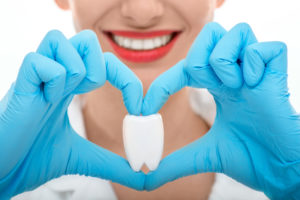
Why to Avoid These Foods
We can give you lists of foods to avoid, but it’s also best to explain why you should avoid these types of foods.
- Hard Foods – Your teeth and even you braces appliances are very hard, however, they are not unbreakable. Even without braces, you want to be careful about eating hard foods, as you could break a tooth. With braces, you could break a bracket or wire or have it come right off the tooth, which is something you don’t want. The hard candies and foods we have listed on foods to avoid are ones that we have seen hurt your teeth time and again. If you must eat hard foods (or if you really want to), cut up foods such as apples into small, bite-sized pieces. However, you should avoid nuts and popcorn hulls at all costs, as there really is no good way around eating these without the chance that you could hurt your teeth or brackets. Without braces, you want to still avoid chewing on ice or hard candies, as you could break or crack a tooth. Suck on hard foods instead.
- Sticky Foods – Sticky foods can sometimes be worse than hard ones and could even hurt your teeth more if you think about the tooth decay they can cause. Even though many sticky foods (such as gum or caramel) are soft, they are so hard to get out of your brackets. These types of foods get stuck and stay stuck long after you’ve finished eating them. Then, you have to spend a lot more time trying to brush and pick at your brackets to remove these foods. If you don’t, sticky candies and foods can sit in your brackets and wires, eroding your tooth enamel and causing tooth decay. If you eat these foods a lot, you could end up with parts of your teeth that are cratered or worn away when you get your braces off.
Cleaning Your Braces
Some tips to follow to avoid plaque buildup and tooth decay include:
- Brushing after every meal. Your braces can easily attract and trap food particles. Instead of brushing just twice a day as the American Dental Association recommends, we suggest brushing after every meal. Brush your teeth with a regular, soft-bristled brush. Brush down from the top and then up from the bottom on each tooth with a bracket to fully dislodge all food.
- Use a floss threader. You can either buy floss threaders or threadable floss. This is floss that you thread through the small spaces between teeth. You pull the floss through and then floss under your wires. The more you practice this, the quicker and easier it becomes. Don’t ever skip flossing just because it takes a bit longer, and floss at least twice a day.
- Use a proxabrush and/or waterpik. A proxabrush is a small christmas-tree brush that you can use to dislodge and clean food easily from brackets. A waterpik is a tool that shoots water in your mouth and brackets to dislodge food.
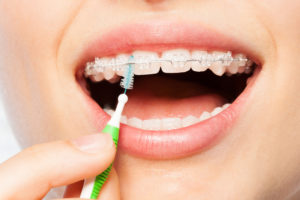
Avoid Actions that Hurt Your Teeth
Follow our guidelines for foods to avoid and what to do if you want to eat those foods. Take meticulous care of your teeth during your time with braces and you will thank yourself for the beautiful smile you’ll have when you get those braces off. If you have questions about foods or other topics that we haven’t covered, call Belmar Orthodontics at (303) 225-9016 for all of your questions!
Your Braces from Start to Finish
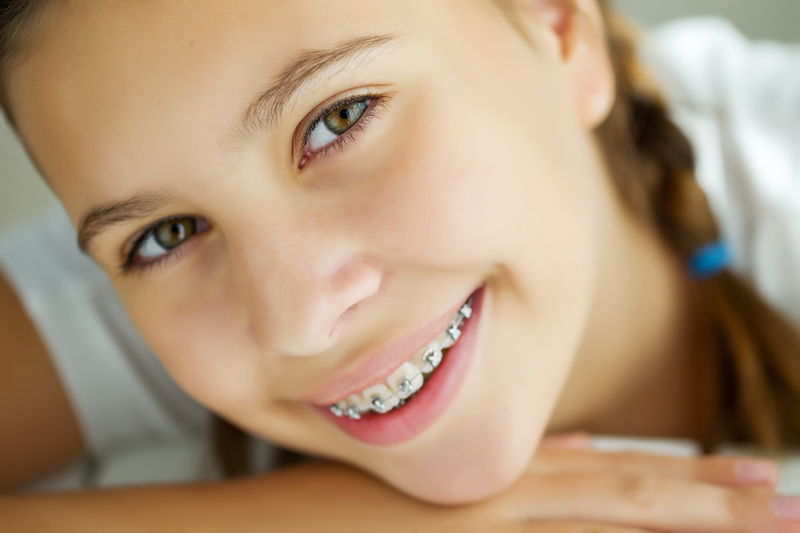
There are many things to think about when deciding to receive your braces. What type of braces should you choose? What age should you receive those braces? Then, after deciding what method of teeth straightening you want, you then have to learn how to properly care for your teeth. You will also have to get used to sometimes having sore teeth after your appointments and fitting in seeing the dentist. We can help you to know about your braces appliance from choosing a braces type, cleaning them, and avoiding tooth decay while you get a straighter smile.
Choosing Your Braces Style
Receiving braces is an exciting time for many people. It is the start of a better smile and a better you. But before you can get that straighter, more beautiful smile, you have to choose what style of braces you want. We offer:
- Traditional Metal Braces – These are the classic metal bracket and wire option that is most commonly chosen by patients. Patients who chose this option come in to have their wires tightened at each appointment.
- Ceramic Braces – These braces are a close cousin to metal braces. They have the same bracket and wire design of metal braces, except that they are made out of ceramic material. This helps decrease demineralization during your orthodontic treatment. Ceramic material is also naturally white, helping these braces to blend in with your teeth more than metal would.
- Lingual Braces – These are metal braces that are placed on the back of your teeth. Instead of just a square bracket, the metal must be custom-made to the shape of the back of your teeth. This is a discrete option that adults and teens love.
- Invisalign Treatment – This is the most invisible option available to our patients. Invisalign is a series of transparent aligners that you wear at night and throughout the day. You can remove them for eating, playing sports, cleaning your teeth and more.
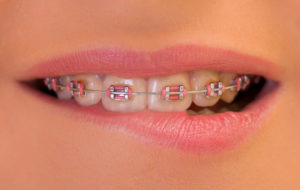
Getting Your Braces Put On
After you’ve chosen the style of braces you want, you need to have them fitted to your mouth. 3 out of the 4 options available to you will be bonded to your actual teeth. At our office, we make sure your teeth are thoroughly cleaned and dried before we bond brackets to them. With metal braces, we will use a cement bonding glue to adhere a metal bracket to the center of each of your teeth. Your back molars might receive a band that goes all the way around the tooth.
Once the metal bracket is cemented to the center of each tooth, we will pass a small metal archwire through each bracket both on top and on bottom. In the end, you will end up with a wire across the teeth on your upper jaw and across the teeth on your lower jaw. The glue we use may taste a bit unpleasant, but it is otherwise harmless. The entire process of getting your brackets and wires placed on your teeth will be between 1 and 2 hours.
The Process for Other Options
Depending on what option you have chosen, your braces process might be a bit different. Ceramic braces are applied the same way that metal braces would be, as they too consist of brackets and wires. However, if you choose to get lingual braces, we can’t simply place brackets on the backs of your teeth. Once Dr. Hardy has determined that you are an ideal candidate for lingual braces, he will take impressions of your teeth. He then sends them to a lab so that your brackets and wires can be custom made. The braces will then be bonded behind your teeth at a separate appointment.
For Invisalign treatment, we design a series of transparent aligners that you will switch out each week. We can take digital impressions of your mouth that we will use to design your aligners. We use a digital scanning system that sends images to a state-of-the-art printing machine. Then, each week you will have new aligners that you will simply replace. It’s that easy!
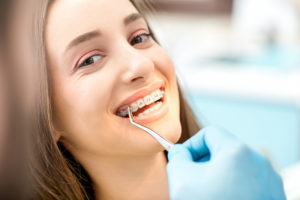
Your Orthodontic Experience
Most patients will have braces for 18-24 months. Some people don’t like braces, but the majority of people do. You can choose the style of your braces and if you want them to be hidden or noticeable. You can also dress up your braces with colorful bands if you so desire. Braces require more care than what you are used to. You must take more time with brushing and flossing, even using tools such as a waterpik, proxabrush and floss threaders to fully remove food from your braces. You must clean your teeth thoroughly to avoid tooth decay during your time with braces. We can show you how to do all of this at our office.
Each patient will come in every 4-6 weeks for orthodontic checkups. This is where we will examine your braces and how your teeth are moving. You will experience initial soreness and discomfort after you first get your braces. You might have this discomfort every time your braces get tightened as well. A simple over-the-counter pain reliever should help you as well as eating soft foods. Having braces changes life a little bit when it comes to cleaning your teeth (which takes longer), but the benefits far outweigh everything else. At the end of your treatment, you will have an amazing, beautiful smile that is sure to wow everyone around you. If you want to know more about your braces options, or want to get started on your journey today, call Belmar Orthodontics today at (303) 225-9016!
Dental Care during Braces
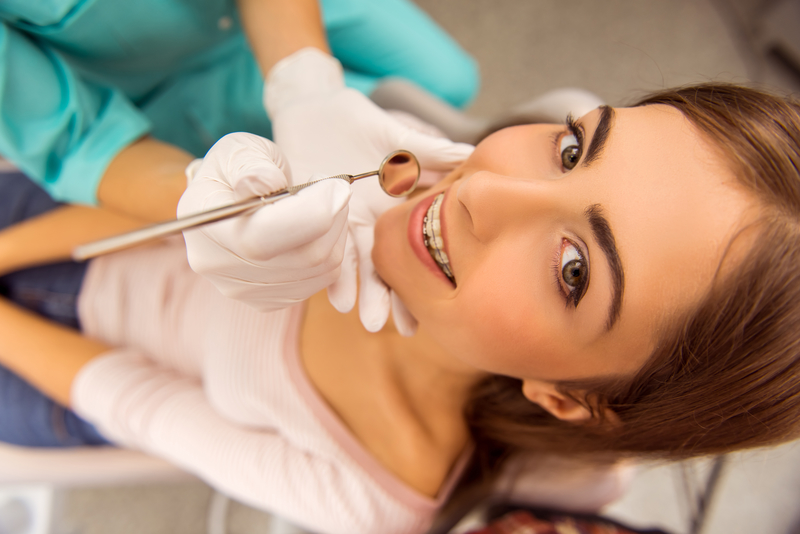
An orthodontist has been to dental school and is skilled enough to spot gum and teeth problems. However, seeing an orthodontist is not enough to keep your teeth healthy. During your time receiving braces, it’s also important to keep seeing a dentist for cleanings, exams and dental treatments. Learn why dental care and oral hygiene is important during your time with braces and how it can help you have a better smile after your braces!
Caring for Metal Braces
Your dental care during braces will depend on the type of braces you receive. If you choose metal braces, brackets and wires in your mouth make it easier for food particles to get stuck. This quickly leads to dental issues if proper care is not taken. You have to be meticulous about cleaning away plaque and stuck food particles so that you avoid tooth decay and demineralization of your tooth enamel. You do this by:
- Brushing after every meal. Your braces easily trap food particles every single time you eat. Brushing after each meal can prevent staining and reduce the potential for bacteria buildup. When brushing, make sure you have a regular, soft-bristle brush. Brush down from the top, then up from the bottom on each tooth that has a bracket.
- Using a threadable floss or floss threader. You will quickly notice that you can’t floss the conventional way with metal braces because the archwire is in the way. If you use a floss threader, thread regular floss through the eye of the threader like you would a sewing needle and thread. Or, using threadable floss, insert the small or pointed end in between your teeth, pulling it through. Once in place between your teeth, you can floss the two teeth on either side of where you have inserted the floss, taking care not to apply force or pressure against the archwire. Repeat between all teeth.
- Using a proxabrush. This is a small brush that looks like a Christmas tree. Place the proxabrush between two brackets, below the archwire, brushing up and down. After several strokes, repeat this motion by inserting the brush from the opposite side (either down from the top or up from the bottom).
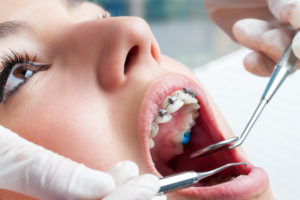
Dental Care with Other Braces
There are other types of braces besides metal braces. At our office, we also offer Invisalign, lingual braces and ceramic braces.
- Ceramic braces – Care for ceramic braces is the same as for traditional metal braces. This is because the design of these braces are the exact same, except they are made out of white, ceramic material.
- Lingual braces – These braces consist of brackets and wires that are placed on the tongue-side of your teeth (meaning behind the teeth). You will have to be more careful with brushing and flossing your teeth, as you won’t be able to see the brackets and wires as well. However, cleaning is very similar to how you would clean metal braces. With flossing, floss threaders will become your best friend, and you’ll want to be meticulous with this because food can get stuck more often with the braces being inside your mouth by your tongue.
- Invisalign – This orthodontic appliance is completely different than the other options you have. Invisalign is a series of transparent aligners that you switch out every week. The benefit of these aligners is that you can easily remove them, and brush and floss your teeth like normal. No brackets, wires or lengthy flossing session. When you take the aligners out, rinse them to get the saliva off of them. Then soak them in a retainer/braces cleaner. An example is Retainer Brite or denture cleaner.
Do You Need to See a Dentist?
Did you know that an orthodontist must complete dental school. In order to practice orthodontics, they need to complete a 4-year bachelor’s degree followed by 4 years of dental school. After that time, an orthodontist will continue 2-3 years of additional training and schooling to practice orthodontics. Therefore, an orthodontist knows what a dentist knows when it comes to your oral health. However, one point that we want to stress is that you need to continue seeing the dentist during your time with braces.
An orthodontist is skilled at treating issues with your oral health, however, an orthodontist is in charge of correcting bite and alignment. A dentist is the one that will need to correct problems with tooth decay and gum disease. Even though an orthodontist has received the same training, their profession is to not to fill cavities or do root canals unless their practice does both. During your time with braces, you must continue receiving dental care from a dentist. Braces raise your risk for tooth decay and gum disease
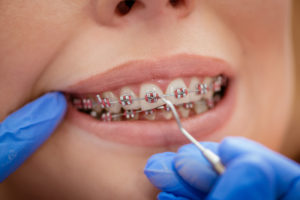
Dental Care during Your Time with Braces
Your dental care during braces will depend on the type of braces you receive. Many patients choose traditional metal braces for straightening their teeth. No matter what orthodontic option you choose, it is particularly important to maintain great dental care through attention to proper oral hygiene. If you don’t know what that proper hygiene routine looks like, we can help you. As always, if you have any questions about braces care or maintenance, please do not hesitate to contact our office. We are here to help you reach your goals and to keep your mouth healthy. For help caring for your braces, or if you are finding certain oral hygiene tasks difficult, call Belmar Orthodontics at (303) 225-9016!
Products that Make Cleaning Braces Easier
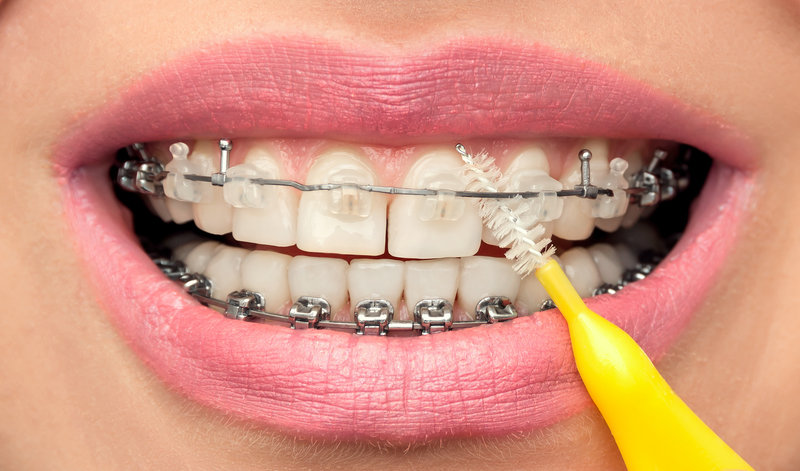
Cleaning the teeth can be hard at times. Cleaning braces on the teeth can be even harder because of all the appliances attached to the enamel. Proper care must be taken with brackets and wires to ensure that all food is removed from the teeth. Brushing and flossing in general helps decrease your likelihood for tooth decay, gum disease, and other oral health issues. Brushing and flossing is different for a smile with braces. There are more guidelines for proper oral hygiene with orthodontic care. Thankfully, there are also products out there (such as flossers) that help make cleaning braces and your teeth easier. Find out how to properly care for your braces and what products can help make cleaning braces easier!
Braces Are Unique to Each Person
Millions of adults will receive braces each year. In fact, there are about 4.5 million people wearing braces annually. In the past, those braces used to all be the traditional style of metal brackets. However, modern technology now affords patients the options of lingual braces, clear ceramic braces, and Invisalign as well.
- Lingual Braces – Many patients want the strength of metal brackets without the braces being so noticeable. Lingual braces are perfect for these patients, as the metal apparatus is attached to the inside of your teeth instead of the outside. You can straighten your teeth without anyone knowing!
- Clear Ceramic Braces – There are other patients that love metal brackets but don’t want the metal to overwhelm their face. Clear ceramic braces are a great option for those who still want brackets, but want them to blend in more with the teeth. Made from ceramic material, these brackets are very durable, naturally help combat demineralization, and are white just like your teeth.
- Invisalign – For a truly invisible straightening system, Invisalign can align your pearly whites discreetly and comfortably. This is a series of removable transparent aligners that you change out every 1-2 weeks. You can take out the aligners for regular brushing and oral care, sports, eating, and more.
Cleaning Braces with Help
It’s vitally important that you take extra good care of your teeth with braces. This is a time when tooth decay can occur in many parts of your mouth. Brackets and wires in your mouth make it easier for food particles to get stuck, leading to other dental issues if proper care is not taken. With braces, we suggest brushing your teeth after every single meal instead of just twice a day. You can use a regular toothbrush, but make sure it is one that you will actually want to use. The toothbrush should have soft bristles so it’s easier on your tooth enamel and the head should fit comfortably in your mouth. Brushing after each meal can help prevent staining and bacteria buildup.
When brushing, brush down from the top, then up from the bottom on each tooth with a bracket. After brushing with your toothbrush, you can get an extra clean by using a proxabrush. This is a special oral health brush that looks very similar to a Christmas tree. It is actually sometimes referred to as a “Christmas tree brush”. You use this small brush by placing it between two brackets below the archwire. Then you brush up and down to dislodge any food you may have missed with brushing or that you didn’t even realize was there. After several strokes, repeat this motion by inserting the brush from the opposite side. For those who want an extra clean, you can use an oral irrigator to blast away food.
What About Flossing?
Many patients have problems flossing the teeth. The main problem is that flossing takes time, and many people either don’t have the time to floss properly, or don’t want to take the time to do it. How well you floss can make quite the difference on what happens to your teeth during your time with braces. Food can easily become stuck in brackets, but we know that food definitely gets stuck between the teeth. This happens even without braces! You may be a pro at cleaning braces, but you also have to be a pro at flossing your teeth with them as well. How do you do this with that pesky archwire that’s in the way?
There are products just for this problem. Use a threadable floss or a floss threader to get the job done. A floss threader is a tool you can use to pull your regular floss through each space between the teeth. Think of a floss threader as a large sewing needle of sorts. You place your floss through the threader. Then, just as a person does with sewing, you will thread the floss threader through each space between the teeth. There is also special floss that has a hard end that is about 2-3 inches in length. Each floss piece can be threaded with the harder end without an additional threader. Every time you floss, make sure to move it back and forth in each space between the teeth, taking care not to apply force or pressure against the archwire.
Cleaning Braces is Easy
You are going to be wearing your braces for 18-24 months, so you’ll have to become comfortable cleaning them efficiently if you want a great smile in the end! Cleaning braces will become second nature to you if you do it often enough. Cleaning braces will help your smile be more beautiful at the end of treatment and will help avoid tooth decay, enamel erosion, demineralization, stains and more. You only get one smile in this life, so treat it right! Many patients benefit from learning more about how to clean their braces and tips and tricks to doing it right and quicker. If you want to learn more about cleaning and caring for your braces, call Belmar Orthodontics today at (303) 225-9016!
Before, After and During Braces
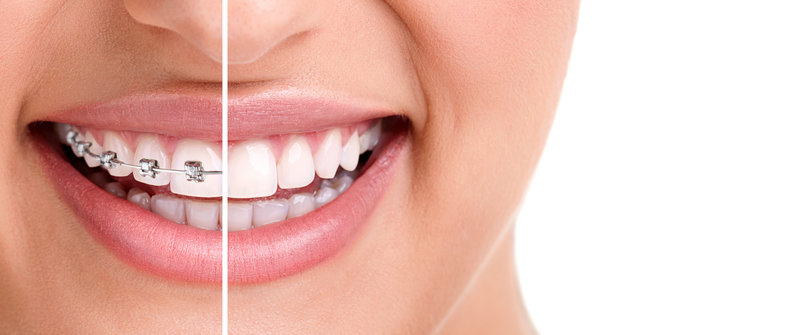
What do you need to know before, after and during braces? How do you prepare for orthodontic care? The American Dental Association says that patients can greatly benefit from both dental and orthodontic care if they want a better smile. Seeing a dentist often as a child can help you prepare for braces in the future. Seeing a dentist and orthodontist early on can also help prevent serious oral health issues. When preparing for braces, you will receive an oral exam, x-rays, and have molds of your teeth made. You may even need dental work done as well. We can help you know what you need to do before braces, during, and after braces to achieve a better smile!
Preparing for Braces
Seeing your dentist is the best way to prepare for braces. The ADA recommends that patients visit their dentist at least biannually (meaning twice a year). Patients who have gum disease or are prone to tooth decay (cavities) may need to visit their dentist more often than that to prevent problems. A dentist can detect abnormal bites or alignment in children. This early detection can help children to see an orthodontist early-on for care before bite and alignment problems become severe. Most patients see an orthodontist around the early adolescent years to straighten the teeth. This is because most alignment problems are apparent after the permanent teeth have come into the mouth.
Studies show that most patients who receive braces are between 8 and 14 years old. You will visit your dentist and then often see an orthodontist after. That orthodontist will do a full exam of your teeth including your jaws and mouth and how your bite and alignment are. X-rays help to determine the position of the teeth in the jaw and help an orthodontist plan how your teeth must move to come into correct alignment during your treatment. Much like a dental office, you will have molds (also called “impressions”) made for your teeth. A plaster model of your teeth will be made that the orthodontist can made a plan from. In preparing for braces, you should plan on between 18-24 months of wearing braces to receive a straight smile. However, know that braces can be fun and are an investment in your future.
Caring for Your Braces
Your braces will be a new experience for you. At first, you may have a tender mouth, as your teeth will have to get used to the new brackets that are on them. Brackets are the squares attached to each tooth. There will be an archwire that runs through each bracket and helps mold your jaw arch correctly. You may also have elastic rubber bands and steel bands in the back of your teeth that are attached to the tooth. You must take extra time each day to care for your braces properly. If you brushed for 2 minutes before braces, you will have to extend that time now. Each bracket can get food stuck in it with any given meal, so it’s important that you brush each tooth and especially brush the bracket at different angles to dislodge food that has become stuck.
Flossing is extra important as well, because it is usually a step that is skipped if patients are short on time. Flossing requires setting aside around 10 minutes of your time to do it right. Use a floss threader to thread the floss under your wire, then floss between your teeth like normal. You will have to thread the floss for each individual tooth, but the time is worth it as it helps to decrease your risk for tooth decay between the teeth. Some patients may need to use a proxy brush or toothpicks to dislodge foods from the brackets. A mouthrinse with fluoride can help keep the teeth healthy as well.
After Your Orthodontic Care
You’ve spent 18-24 months to get a better smile. Now what? It is highly important to wear your retainer every single day after your braces come off. Your teeth have been moved into place very recently and can even start changing back into their crooked paths in the first month after braces if the retainer is not worn. Wear your retainer according to what the orthodontist suggests. If you follow their recommendations for taking care of your smile, you can look forward to many decades of a better smile with beautiful teeth.
A smile is not complete once it is straight. You still must brush and floss the teeth every single day to prevent tooth decay and gum disease, both of which can destroy your smile. However, both of these are avoidable if you follow basic oral hygiene.
A Better Smile Today
If you care for your braces well, then you can expect to have a beautiful smile after your treatment is over. A better smile can bring you added confidence and success, which is what we want for every patient. If you are preparing for braces, follow our recommendations. You can even learn more about preparation, what to do with braces in special circumstances, and ask questions you may have after your care is over. Simply call our Belmar Orthodontics office at (303) 225-9016 to know more!
Receiving Dental Care with Braces
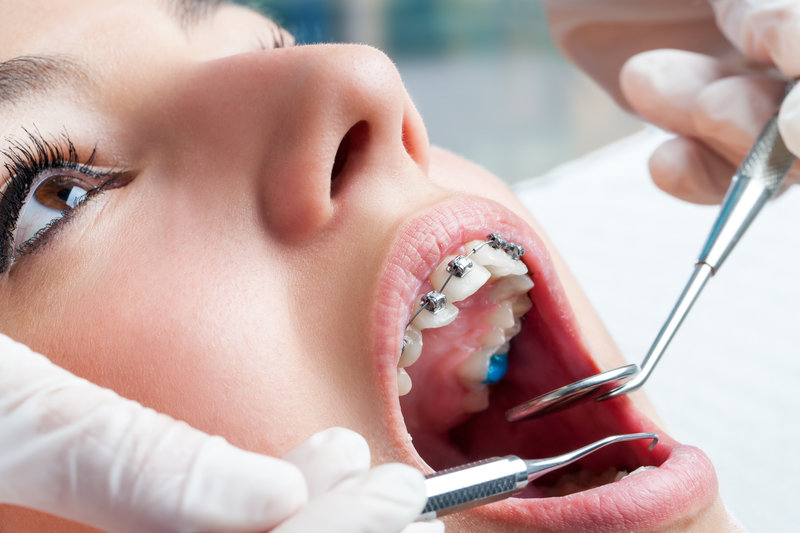
Dentist hands working on young teen patient with dental braces.
Should you receive dental care with braces or is seeing the orthodontist sufficient? Continue regular checkups with your dentist even if you are frequently seeing your orthodontist. Braces make you more prone to problems such as plaque buildup and tartar. Depending on the kind of braces you choose, your teeth may require additional steps to stay clean with braces than without. For some, the enamel can also weaken with braces. However, there are ways to keep your teeth healthy and clean while you have braces. Modern-day orthodontics offers treatment options everyone can be comfortable with and will still allow patients to receive proper dental care at the same time. We can answer frequently asked questions for receiving dental care with braces and help you with tips for taking care of your braces so your smile stays healthy.
Dentists and Orthodontists
Did you know that orthodontists attend dental school just like dentists do? Dentists and orthodontists are similar in their schooling up to a point. However, although both professions deal with the health of your teeth, they both do separate services. Dentists perform services such as:
- Comprehensive exams and diagnostic x-rays
- Dental cleanings
- Oral cancer screening
- Laser tissue treatment
- Periodontal treatment/Scaling and root planing
- Dental sealants
- Cavity fillings/Tooth colored fillings
- Sedation dentistry
- Porcelain veneers and crowns
- Cosmetic bonding
- Dental bridges and dental implants
- Root canal therapy
- Teeth whitening
An orthodontist performs other services different than a dentist, although they are skilled in dental practices. Orthodontists receive 4 years of undergraduate education, where they then attend dental school for 4 years. After dental school, they attend a postdoctoral program to learn orthodontia. A dentist fixes problems with your teeth in general, while an orthodontist fixes problems with teeth alignment as well as your bite and jaw alignment. Basically, every orthodontist is a dentist, but not every dentist is an orthodontist. Patients benefit from having both a dentist and an orthodontist to maintain a healthy mouth.
Caring for Your Teeth
Taking care of your teeth is a bit different with braces than it was without them. During your orthodontic treatment, it is particularly important to maintain good oral health through proper oral hygiene. Brackets and wires in your mouth make it much easier for food particles to get stuck. When those food particles are not removed, it leads to other dental issues like tooth decay (cavities) and gum disease. Your teeth may also demineralize or erode in the areas where your brackets were attacked to the teeth. Areas on the enamel surface lose minerals in this case, which is what causes white squares to form on the teeth. If you drink beverages that stain the teeth easily, you might be left with uneven stains once the brackets have been removed.
With braces, you should still follow the American Dental Association’s recommendation to brush the teeth at least twice a day. We recommend that you brush the teeth much more than that, as food particles can get stuck in the brackets at every single meal. Make sure to avoid hard foods like hard candies, chips, apples, nuts, popcorn and more with your brackets. Also avoid sticky foods such as gum, caramel, taffy, tootsie rolls, and gummies as these foods are much harder to get out of all the small areas of your braces. A lot of caring for your braces is watching what you eat and then cleaning the teeth often after you do eat.
Cleaning with Braces
Flossing is one of the daily tasks that will be more difficult with braces because there is an archwire that blocks the floss from going in and out of the spaces between the teeth with ease. The solution for this is to use threadable floss or a floss threader. With a floss threader, you use regular floss and thread it through the eye of the threader much like you would with a sewing needle and thread. You then floss the threader between each tooth individually. Floss that comes threadable will be harder at one end and will be able to be threaded between the teeth without having to have a separate threader.
After brushing with a toothbrush, you can also use a proxabrush, which looks like a small Christmas tree brush. You place this proxabrush between two brackets, below the archwire, and you brush up and down. This will get food that is hard-stuck in your brackets. Brushing after every meal will reduce how much food gets into your bracket and stays there.
Dental Care with Braces
Even though you are seeing an orthodontist frequently, you must continue to visit your dentist throughout your care! An orthodontist will get your teeth straight, but you receive dental cleanings, comprehensive exams, and cavity care from a dentist, not an orthodontist. Both professions deal with the teeth, but they both deal differently with the teeth. Only a dentist can find cavities and fill them for you. A dentist can provide all the services we listed above, which are all very important to keep the teeth healthy. Receiving frequent dental exams and cleanings are some of the best dental services you can receive while wearing braces, because keeping the teeth clean and free of cavities will help your smile be that much more beautiful in the end.
Schedule a Dental Visit
Your tooth enamel can suffer permanent damage if you don’t take extra care with your teeth with braces. That’s why it’s even more important to receive dental care while you have braces. Be vigilant with your oral hygiene every single day. Don’t skip days! You are spending months of your life to receive a straighter smile. You want that smile to also be a beautiful one at the end of your treatment. In the end, it is very important to receive dental care during braces and to take care of them yourself every day at home. If you have questions about caring for your braces, call our Belmar Orthodontics office today at (303) 225-9016.

